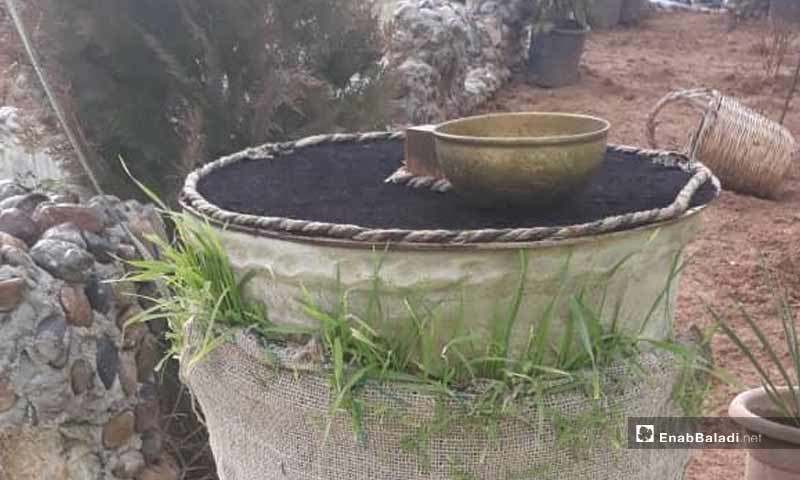



His obsession with preserving heritage and identity, his obsession with archeological antiquities and possessions and his passion for all that is vintage triggered him to open the “Vintage Kurdish House” individually.
In the al-Mufti neighborhood, al-Hasakah city, Hamza Mohammad opened his museum, which exhibits hundreds of Kurdish vintage antiquities.
A people is alive, as long as its folklore, art and culture continue to exist, as it is the communication bridge, connecting grandfathers with their grandchildren. The popular heritage has always been a basic element to preserve identity, for, in time, the cultural and civilizational heritage constituted the accumulation of the human beings’ experience, through their dialogue with nature and other cultures; it is the outcome of his past’s experiences, expressed by what predecessors left of material properties, such as clothing, utensils, jewelry and documents, recording the spirit of the people, their culture and the pulse of their life.
Hamza told Enab Baladi that following his return from Iraqi Kurdistan, where he took refuge along with his family due to the Syrian war’s conditions, living there for five years, he decided to realize his old dream, which he always contemplated. He made the decision to establish a big house, to gather all that has a relation to the Kurdish heritage of the ancient crafts that distinguished the Kurdish rural household in the past.
Hamza started his project with a small shop at the al-Mufti roundabout, the city of al-Hasakah, where he showcased vintage antiquities made of copper and silver and carpets, he brought from Kurdistan. The shop witnessed a massive demand on the part of the visitors, who came to see the unique antiquities, which do not exist in other Syrian areas.
Due to the war, Hamza said, many Syrian areas lost their heritage antiquities. In Aleppo, for example, there were many of these pieces, and in other areas. Accordingly, the majority of the visitors come with a longing for seeing this heritage and knowing more details about it.
Hamza pointed out that all the pieces are vintage and are all handmade. This project is his source of living, for the pieces were in a demand in a manner that helped him expand his project six months from the opening.
To continue his dream, Hamza changed his house, the space of which is 500 square meters, into an exhibition for Kurdish folkloric vintage pieces. Today, it showcases more than 800 pieces, which took years to collect.
These pieces include archeological musical instruments and Kurdish, Iraqi, Turkish, Yemeni and Saudi Arabian swords and daggers, upon each the name of the owner and the date is engraved.
In addition to this, there are many of the pieces that the Kurdish families used in their countryside houses, including all types of old carpets, some of which date back to the era of “Zoroaster”, the founder of “Zoroastrianism”, the stone threshing utensil, the copper utensil that followed and various types of grinding stones, used for grinding wheat and making flour, the old urns used to preserve food, irons that operated using coal and then using babor, the oven which predecessors used for making bread and coffee bots, carrying the names of the tribes’ leaders which date back to 200 hundred years ago, in addition to copper-made coffee cups and glasses, rosaries and handmade old school bags, decorated with traditional familiar shapes, rings, vintage pocket, and hand watches.
Each piece has the features that distinguish it, some carry the date of making, with embossed or deep engravings.
Hamza stressed that the key objective of his project is the revival of the Kurdish heritage and preserving this wealth and to turn the place to a destination for interested people.
He pointed out that the Kurdish region is striving with heritage pieces, and only a few try to exhibit the dimensions of beauty they possess. He added that the majority of the people do not much value these pieces or neglect them. However, when they see them at the museum and ask about their date, they acknowledge their importance and start showing more care and a tendency to preserve them.
Hamza believes that some pieces are priceless, so he does not sell them no matter what the offer is because he cannot give up on them, pointing out that many poets, literary figures and artists visit the place, where they spend hours watching and enjoying what is displayed.
For long years, the Kurdish people were denied the right to preserve their original identity and cultural heritage. In 1986, a decree was issued, preventing the usage of Kurdish language, and the thing did not stop there, as it covered all that indicates the Kurdish culture.
In 1987, the Ministry of Culture prohibited Kurdish music and criminalized the printing and exchange of books, written in Kurdish, which robbed the Kurds of their right into expressing their identity and contributed to enhancing their feelings of alienation and the melting of their identity.
The Kurds are the fourth largest ethnic group in the middle east, with a population ranging from 30 to 40 million persons.
if you think the article contain wrong information or you have additional details Send Correction